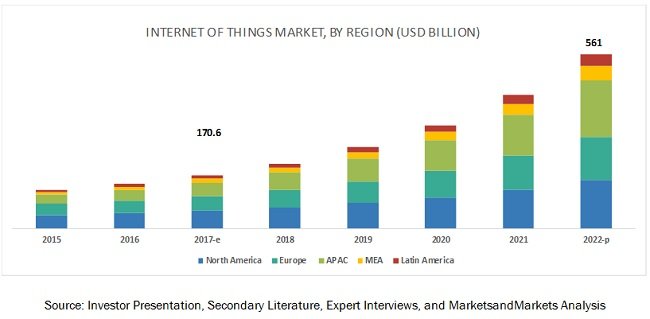With the advent of IoT and proliferation of connected devices across a variety of industry verticals, we are seeing a slew of new security vulnerabilities emerging. We live in an era where everything has turned ‘smart’: Smartphone, smart home, smart lock, smart camera and so on. A day going by without interacting with an internet connected device seems next to impossible. IoT has created a more competitive business environment and manufacturers continue to compete on getting the latest product in the hands of consumers. The rate in which IoT is growing is astonishing with its global market believed to reach 561 billion by 2022. Governments around the world such as the U.S. and U.K. are starting to react to this massive shift by implementing new IoT security measures.

But what are the largest security challenges troubling the field of IoT devices?
Rise of botnets, malware and ransomware
Botnets have been on the rise due to the increase in the number of connected devices. A botnet is when hackers remotely access and control internet connected devices and use them for illegal means. Devices could be invited to malicious activities as part of a botnet without owners having any knowledge of it.
While the traditional ransomware relies on encryption to completely lock out users out of different devices, there’s an ongoing mix of both malware and ransomware that aims to merge the different types of attack. The ransomware attacks focuses on disabling device functionality and stealing user data at the same time.
Data privacy and security
Data privacy and security remains the single most concerns with connected devices. Data is continuously being gathered, transferred, processed and stored by large companies using a wide variety of smart devices such as smart TVs, speakers and thermostats. All of these devices generate user-data that is shared between or even sold to various companies, violating our rights for privacy and data security. This was at the core of the issue in the Facebook and Cambridge Analytica data scandal.
Insufficient software updates
Software updates is one way to ensure that IoT devices are as secure as they can be. Most of these devices don’t get enough updates while others don’t get updates at all. This means that a device that was initially purchased and thought of being secure becomes insecure and eventually prone to hackers and other security issues through the product life cycle. Manufacturers are more concerned with time-to-market without giving security too much thought. Some of them offer updates only in the initial phase of the product launch and for a short period of time after but stop short the moment they start working on the ‘next big thing’. This leaves their customers exposed to potential attacks as a result of outdated software.
Recent articles
The struggle to reach global markets for medical device manufacturers: The importance of international compliance
The differences between the US FDA’s device approval process and the EU’s medical device regulation (MDR): An essential dual-compliance framework for global manufacturers
Why OTA updates are now mission critical for future-proofed device lifecycle management
Learn why leading companies choose Mender
Discover how Mender empowers both you and your customers with secure and reliable over-the-air updates for IoT devices. Focus on your product, and benefit from specialized OTA expertise and best practices.




